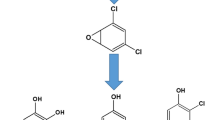Abstract
Objective: The aim of this study was to obtain toxicokinetic data on the absorption and elimination of monochlorobenzene (MCB) in blood and its main metabolite 4-chlorocatechol (4-ClCat) as well as on the isomeric chlorophenols (o-ClPh, m-ClPh, and especially p-ClPh as the main ClPh metabolite) in urine for re-evaluation of the biological tolerance (BAT) value of MCB. Methods: Eight subjects performed 8-h inhalation tests daily over five successive days in an exposure chamber, at a maximum allowable concentration at the workplace (MAK) value of 10 ppm MCB. Five and two probands carried out the test series during physical activity levels of 75 and 50 W, respectively, for 10 min/h on a bicycle ergometer, and one subject was exposed continuously while at rest. MCB and its metabolites were analyzed by gas chromatography in combination with mass spectrometry. Results: The mean MCB blood concentration of the five subjects exposed during physical activity of 75 W was 217 ± 42 μg/l. The relationship of the mean blood concentration measured under the conditions of rest or 50 and 75 W activity levels was in a ratio of about 1:1.7:2.8. The half-life values in the first hour after ending the exposures were 53 min and 150 min for the ensuing period, with steady-state being reached after 45 min. The mean 4-ClCat concentration in urine at the end of the five days was 150 ± 13 mg/g creatinine in the case of the subjects exposed at 75 W, which decreased to 25 mg/g creatinine at the beginning of the next exposure. The analogous p-ClPh concentrations were 25 ± 2 and 9 ± 2 mg/g creatinine. The elimination half-life values of the ClPh isomers ranged from 12.4 to 16.5 h, and the half-life of 4-ClCat was 6.4 h. There was no apparent tendency for MCB and its metabolites to accumulate in blood or urine. Conclusions: The results are in accordance with relevant field and laboratory studies. Taken into consideration with the 95th percentile, the evaluated BAT values should be set at levels of 300 μg MCB/l blood, 175 mg 4-ClCat/g creatinine or alternatively at 30 mg p-ClPh/g creatinine in urine after the end of a shift. At the beginning of the next shift, the BAT values of the metabolites should be 35 and 15 mg/g creatinine, respectively.
Similar content being viewed by others
Author information
Authors and Affiliations
Additional information
Received: 20 December 1999 / Accepted: 25 April 2000
Rights and permissions
About this article
Cite this article
Knecht, U., Woitowitz, HJ. Human toxicokinetics of inhaled monochlorobenzene: latest experimental findings regarding re-evaluation of the biological tolerance value. Int Arch Occup Environ Health 73, 543–554 (2000). https://doi.org/10.1007/s004200000171
Issue Date:
DOI: https://doi.org/10.1007/s004200000171




